Discussion Regarding Audit Risks of API
VerifiedAdded on 2023/03/17
|15
|3872
|98
AI Summary
This memo discusses the audit risks of API and the appropriate audit procedures to address them. It analyzes key ratios and their impact on the financial position of the business. The memo also highlights weaknesses in the internal control system for inventory and suggests necessary audit procedures.
Contribute Materials
Your contribution can guide someone’s learning journey. Share your
documents today.
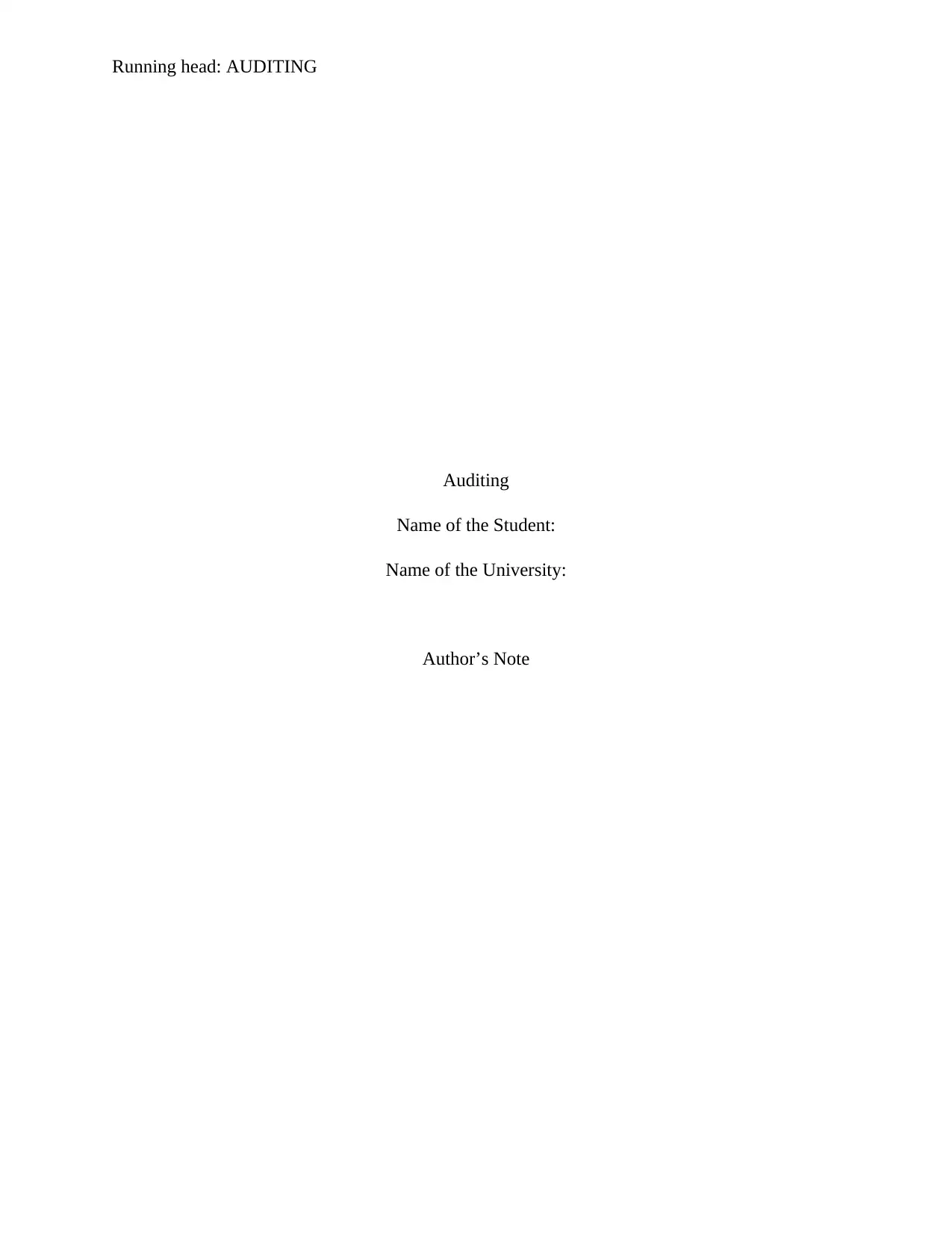
Running head: AUDITING
Auditing
Name of the Student:
Name of the University:
Author’s Note
Auditing
Name of the Student:
Name of the University:
Author’s Note
Secure Best Marks with AI Grader
Need help grading? Try our AI Grader for instant feedback on your assignments.
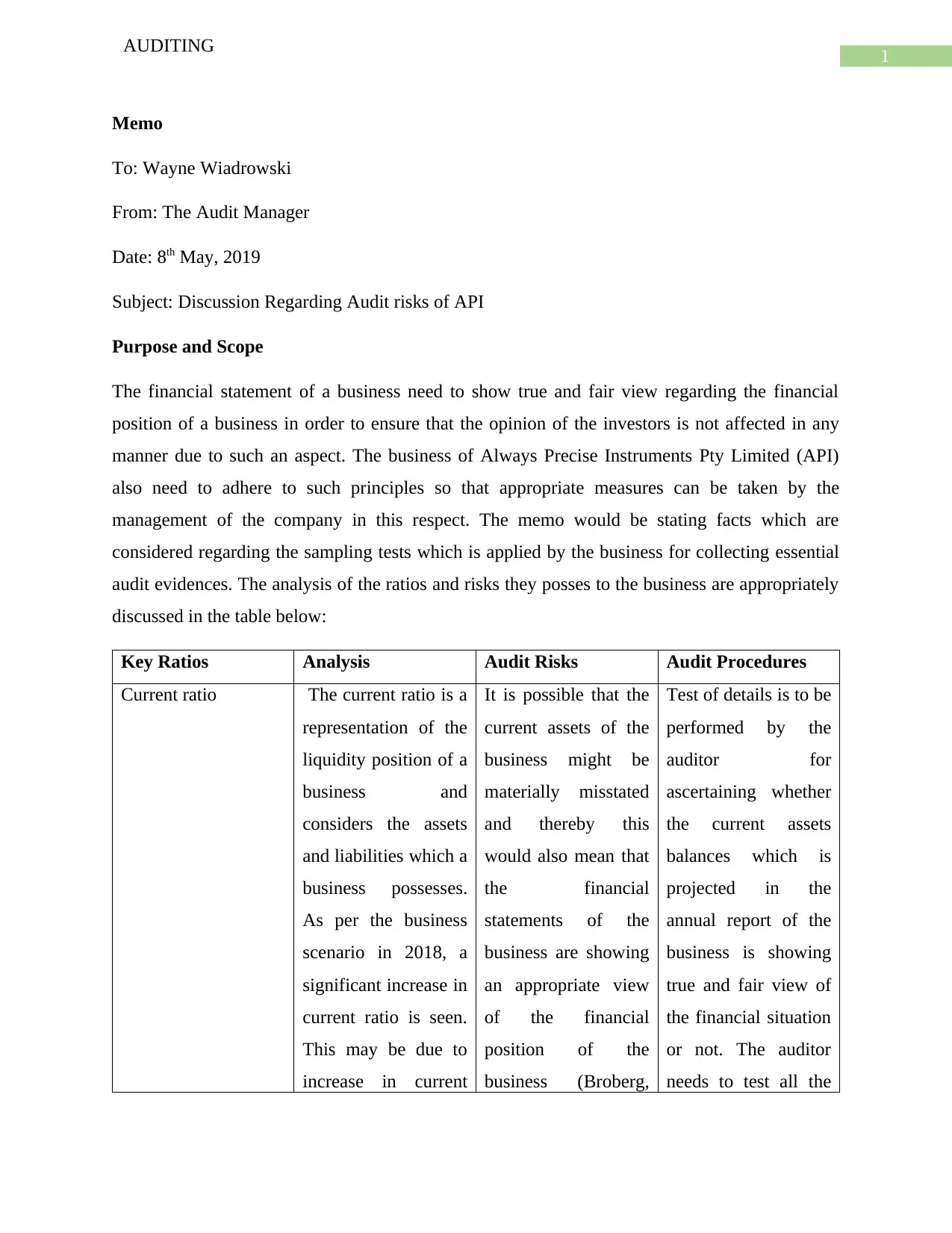
1
AUDITING
Memo
To: Wayne Wiadrowski
From: The Audit Manager
Date: 8th May, 2019
Subject: Discussion Regarding Audit risks of API
Purpose and Scope
The financial statement of a business need to show true and fair view regarding the financial
position of a business in order to ensure that the opinion of the investors is not affected in any
manner due to such an aspect. The business of Always Precise Instruments Pty Limited (API)
also need to adhere to such principles so that appropriate measures can be taken by the
management of the company in this respect. The memo would be stating facts which are
considered regarding the sampling tests which is applied by the business for collecting essential
audit evidences. The analysis of the ratios and risks they posses to the business are appropriately
discussed in the table below:
Key Ratios Analysis Audit Risks Audit Procedures
Current ratio The current ratio is a
representation of the
liquidity position of a
business and
considers the assets
and liabilities which a
business possesses.
As per the business
scenario in 2018, a
significant increase in
current ratio is seen.
This may be due to
increase in current
It is possible that the
current assets of the
business might be
materially misstated
and thereby this
would also mean that
the financial
statements of the
business are showing
an appropriate view
of the financial
position of the
business (Broberg,
Test of details is to be
performed by the
auditor for
ascertaining whether
the current assets
balances which is
projected in the
annual report of the
business is showing
true and fair view of
the financial situation
or not. The auditor
needs to test all the
AUDITING
Memo
To: Wayne Wiadrowski
From: The Audit Manager
Date: 8th May, 2019
Subject: Discussion Regarding Audit risks of API
Purpose and Scope
The financial statement of a business need to show true and fair view regarding the financial
position of a business in order to ensure that the opinion of the investors is not affected in any
manner due to such an aspect. The business of Always Precise Instruments Pty Limited (API)
also need to adhere to such principles so that appropriate measures can be taken by the
management of the company in this respect. The memo would be stating facts which are
considered regarding the sampling tests which is applied by the business for collecting essential
audit evidences. The analysis of the ratios and risks they posses to the business are appropriately
discussed in the table below:
Key Ratios Analysis Audit Risks Audit Procedures
Current ratio The current ratio is a
representation of the
liquidity position of a
business and
considers the assets
and liabilities which a
business possesses.
As per the business
scenario in 2018, a
significant increase in
current ratio is seen.
This may be due to
increase in current
It is possible that the
current assets of the
business might be
materially misstated
and thereby this
would also mean that
the financial
statements of the
business are showing
an appropriate view
of the financial
position of the
business (Broberg,
Test of details is to be
performed by the
auditor for
ascertaining whether
the current assets
balances which is
projected in the
annual report of the
business is showing
true and fair view of
the financial situation
or not. The auditor
needs to test all the
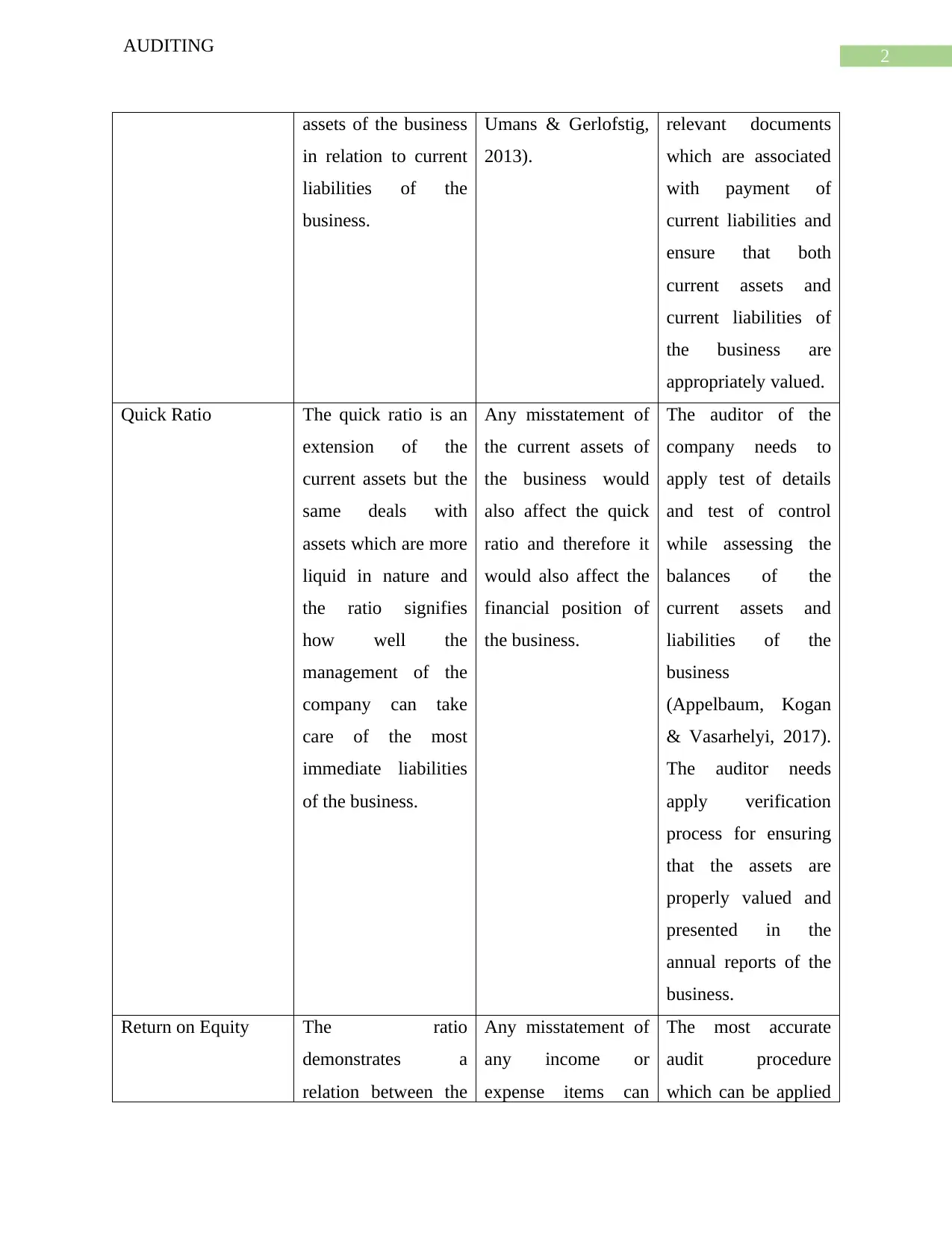
2
AUDITING
assets of the business
in relation to current
liabilities of the
business.
Umans & Gerlofstig,
2013).
relevant documents
which are associated
with payment of
current liabilities and
ensure that both
current assets and
current liabilities of
the business are
appropriately valued.
Quick Ratio The quick ratio is an
extension of the
current assets but the
same deals with
assets which are more
liquid in nature and
the ratio signifies
how well the
management of the
company can take
care of the most
immediate liabilities
of the business.
Any misstatement of
the current assets of
the business would
also affect the quick
ratio and therefore it
would also affect the
financial position of
the business.
The auditor of the
company needs to
apply test of details
and test of control
while assessing the
balances of the
current assets and
liabilities of the
business
(Appelbaum, Kogan
& Vasarhelyi, 2017).
The auditor needs
apply verification
process for ensuring
that the assets are
properly valued and
presented in the
annual reports of the
business.
Return on Equity The ratio
demonstrates a
relation between the
Any misstatement of
any income or
expense items can
The most accurate
audit procedure
which can be applied
AUDITING
assets of the business
in relation to current
liabilities of the
business.
Umans & Gerlofstig,
2013).
relevant documents
which are associated
with payment of
current liabilities and
ensure that both
current assets and
current liabilities of
the business are
appropriately valued.
Quick Ratio The quick ratio is an
extension of the
current assets but the
same deals with
assets which are more
liquid in nature and
the ratio signifies
how well the
management of the
company can take
care of the most
immediate liabilities
of the business.
Any misstatement of
the current assets of
the business would
also affect the quick
ratio and therefore it
would also affect the
financial position of
the business.
The auditor of the
company needs to
apply test of details
and test of control
while assessing the
balances of the
current assets and
liabilities of the
business
(Appelbaum, Kogan
& Vasarhelyi, 2017).
The auditor needs
apply verification
process for ensuring
that the assets are
properly valued and
presented in the
annual reports of the
business.
Return on Equity The ratio
demonstrates a
relation between the
Any misstatement of
any income or
expense items can
The most accurate
audit procedure
which can be applied
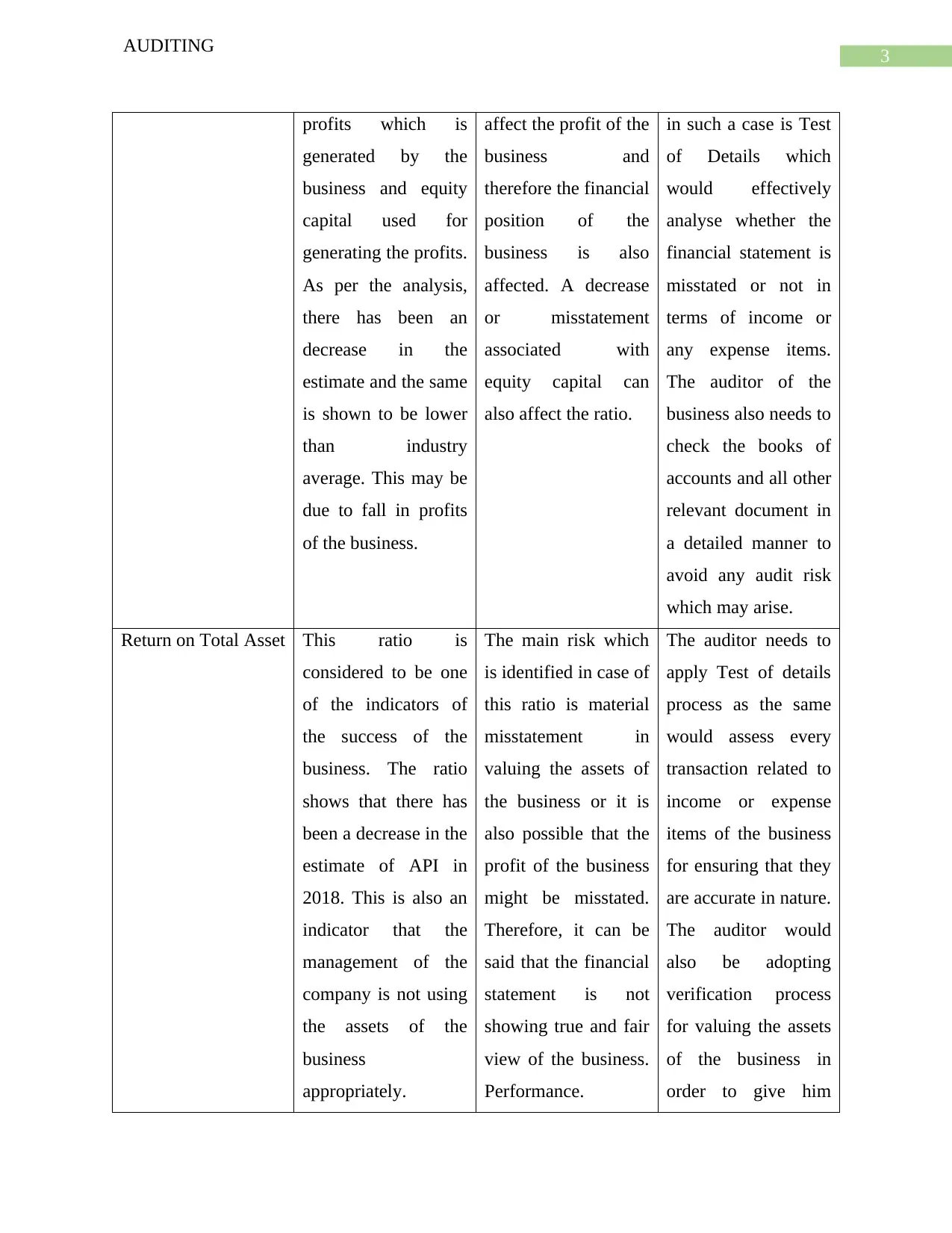
3
AUDITING
profits which is
generated by the
business and equity
capital used for
generating the profits.
As per the analysis,
there has been an
decrease in the
estimate and the same
is shown to be lower
than industry
average. This may be
due to fall in profits
of the business.
affect the profit of the
business and
therefore the financial
position of the
business is also
affected. A decrease
or misstatement
associated with
equity capital can
also affect the ratio.
in such a case is Test
of Details which
would effectively
analyse whether the
financial statement is
misstated or not in
terms of income or
any expense items.
The auditor of the
business also needs to
check the books of
accounts and all other
relevant document in
a detailed manner to
avoid any audit risk
which may arise.
Return on Total Asset This ratio is
considered to be one
of the indicators of
the success of the
business. The ratio
shows that there has
been a decrease in the
estimate of API in
2018. This is also an
indicator that the
management of the
company is not using
the assets of the
business
appropriately.
The main risk which
is identified in case of
this ratio is material
misstatement in
valuing the assets of
the business or it is
also possible that the
profit of the business
might be misstated.
Therefore, it can be
said that the financial
statement is not
showing true and fair
view of the business.
Performance.
The auditor needs to
apply Test of details
process as the same
would assess every
transaction related to
income or expense
items of the business
for ensuring that they
are accurate in nature.
The auditor would
also be adopting
verification process
for valuing the assets
of the business in
order to give him
AUDITING
profits which is
generated by the
business and equity
capital used for
generating the profits.
As per the analysis,
there has been an
decrease in the
estimate and the same
is shown to be lower
than industry
average. This may be
due to fall in profits
of the business.
affect the profit of the
business and
therefore the financial
position of the
business is also
affected. A decrease
or misstatement
associated with
equity capital can
also affect the ratio.
in such a case is Test
of Details which
would effectively
analyse whether the
financial statement is
misstated or not in
terms of income or
any expense items.
The auditor of the
business also needs to
check the books of
accounts and all other
relevant document in
a detailed manner to
avoid any audit risk
which may arise.
Return on Total Asset This ratio is
considered to be one
of the indicators of
the success of the
business. The ratio
shows that there has
been a decrease in the
estimate of API in
2018. This is also an
indicator that the
management of the
company is not using
the assets of the
business
appropriately.
The main risk which
is identified in case of
this ratio is material
misstatement in
valuing the assets of
the business or it is
also possible that the
profit of the business
might be misstated.
Therefore, it can be
said that the financial
statement is not
showing true and fair
view of the business.
Performance.
The auditor needs to
apply Test of details
process as the same
would assess every
transaction related to
income or expense
items of the business
for ensuring that they
are accurate in nature.
The auditor would
also be adopting
verification process
for valuing the assets
of the business in
order to give him
Secure Best Marks with AI Grader
Need help grading? Try our AI Grader for instant feedback on your assignments.

4
AUDITING
satisfaction that the
same is showing a
true and fair view.
Gross Margin The gross profit
margin of the
business is shown to
be on fall in 2018 and
the ratio is also
shown to be lower
than industry
average. The cause
for the same might be
due to low sales or
low profits of the
business or high cost
of sales in the
business.
Audit risks arises
when there is a
misstatement in value
of sales or profits or
cost of sales of the
business. This would
wrongly represent the
profits of the business
and affect the
decision-making
process of the
investors of the
company.
The main tests which
can be applied by the
auditor in such a case
is test of details and
test of control. The
auditor needs to
check all the balances
of the transactions
relating to sales of
trading expenses and
in combination to
this, the auditor also
needs to check
whether the internal
control system is
working
appropriately or not.
Marketing Expenses The marketing
expenses of the
business reveal a
significant increase
which can affect the
profitability of the
business directly.
Any misstatement in
the market expenses
of the business would
affect the total costs
and profits of the
business thereby
misrepresenting them
for the business of
API.
In such a case, test of
details is the correct
approach which the
auditor of the
company needs to
adopt in order to
ascertain the
expenses figures are
showing accurate
results or not (Hay,
2014). Misstatement
AUDITING
satisfaction that the
same is showing a
true and fair view.
Gross Margin The gross profit
margin of the
business is shown to
be on fall in 2018 and
the ratio is also
shown to be lower
than industry
average. The cause
for the same might be
due to low sales or
low profits of the
business or high cost
of sales in the
business.
Audit risks arises
when there is a
misstatement in value
of sales or profits or
cost of sales of the
business. This would
wrongly represent the
profits of the business
and affect the
decision-making
process of the
investors of the
company.
The main tests which
can be applied by the
auditor in such a case
is test of details and
test of control. The
auditor needs to
check all the balances
of the transactions
relating to sales of
trading expenses and
in combination to
this, the auditor also
needs to check
whether the internal
control system is
working
appropriately or not.
Marketing Expenses The marketing
expenses of the
business reveal a
significant increase
which can affect the
profitability of the
business directly.
Any misstatement in
the market expenses
of the business would
affect the total costs
and profits of the
business thereby
misrepresenting them
for the business of
API.
In such a case, test of
details is the correct
approach which the
auditor of the
company needs to
adopt in order to
ascertain the
expenses figures are
showing accurate
results or not (Hay,
2014). Misstatement
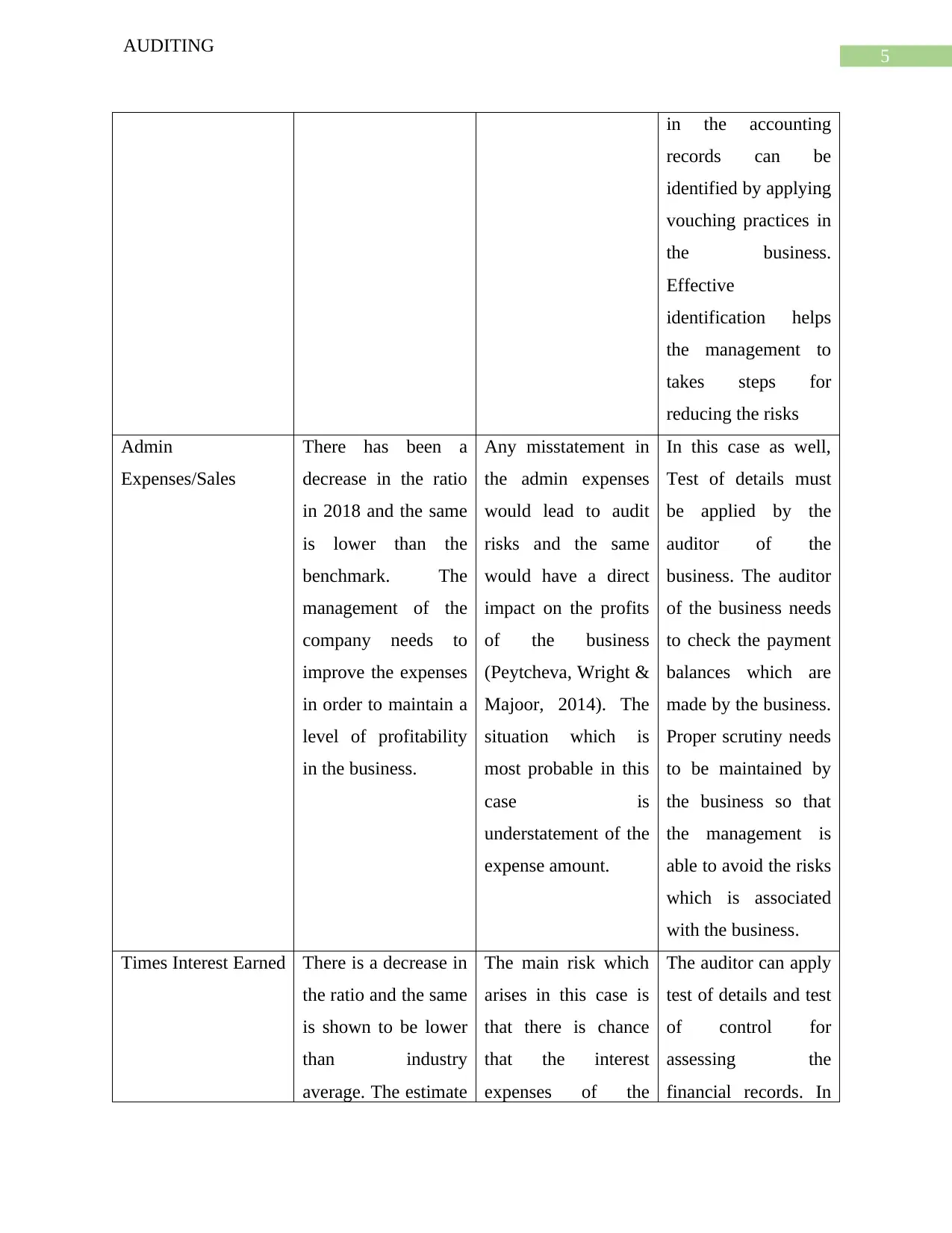
5
AUDITING
in the accounting
records can be
identified by applying
vouching practices in
the business.
Effective
identification helps
the management to
takes steps for
reducing the risks
Admin
Expenses/Sales
There has been a
decrease in the ratio
in 2018 and the same
is lower than the
benchmark. The
management of the
company needs to
improve the expenses
in order to maintain a
level of profitability
in the business.
Any misstatement in
the admin expenses
would lead to audit
risks and the same
would have a direct
impact on the profits
of the business
(Peytcheva, Wright &
Majoor, 2014). The
situation which is
most probable in this
case is
understatement of the
expense amount.
In this case as well,
Test of details must
be applied by the
auditor of the
business. The auditor
of the business needs
to check the payment
balances which are
made by the business.
Proper scrutiny needs
to be maintained by
the business so that
the management is
able to avoid the risks
which is associated
with the business.
Times Interest Earned There is a decrease in
the ratio and the same
is shown to be lower
than industry
average. The estimate
The main risk which
arises in this case is
that there is chance
that the interest
expenses of the
The auditor can apply
test of details and test
of control for
assessing the
financial records. In
AUDITING
in the accounting
records can be
identified by applying
vouching practices in
the business.
Effective
identification helps
the management to
takes steps for
reducing the risks
Admin
Expenses/Sales
There has been a
decrease in the ratio
in 2018 and the same
is lower than the
benchmark. The
management of the
company needs to
improve the expenses
in order to maintain a
level of profitability
in the business.
Any misstatement in
the admin expenses
would lead to audit
risks and the same
would have a direct
impact on the profits
of the business
(Peytcheva, Wright &
Majoor, 2014). The
situation which is
most probable in this
case is
understatement of the
expense amount.
In this case as well,
Test of details must
be applied by the
auditor of the
business. The auditor
of the business needs
to check the payment
balances which are
made by the business.
Proper scrutiny needs
to be maintained by
the business so that
the management is
able to avoid the risks
which is associated
with the business.
Times Interest Earned There is a decrease in
the ratio and the same
is shown to be lower
than industry
average. The estimate
The main risk which
arises in this case is
that there is chance
that the interest
expenses of the
The auditor can apply
test of details and test
of control for
assessing the
financial records. In

6
AUDITING
signifies that the
company has made
lower interest
payment during the
year.
business might be
understated which
would create a
material misstatement
in the financial
accounts of the
business.
this instances, the
auditor also needs to
check all the other
details which are
applicable to verify
that the financial
statement are free
from material
misstatements
Days in Inventory The estimate which is
shown in the analysis
reveal that there is a
decline in inventory
days for API in 2018
which is a clear
signal that the
management of the
company is trying to
clear all stocks for
more revenue
A material
misstatement can take
place while valuing
the stock of the
business
(Christensen, Elder &
Glover, 2014). This
would have direct
impact on the profits
which is generated by
the business.
The auditor should
apply test of control
as the auditor needs
to check whether the
internal control of the
business is properly
working or not and
whether the
implemented policies
of the business are
appropriately
working.
Days in Accounts
Receivable
As per the analysis of
the ratio conducted
there has been an
increase in days of
account receivables
of API.
The misstatement if
the balances of
account receivables
creates potential audit
risks for the business.
The balances of the
debtors might be
overstated which may
be due to inaccurate
policies of the
The auditor of the
business needs to
apply test of internal
control so as to
identify the
weaknesses in
internal control
system.
AUDITING
signifies that the
company has made
lower interest
payment during the
year.
business might be
understated which
would create a
material misstatement
in the financial
accounts of the
business.
this instances, the
auditor also needs to
check all the other
details which are
applicable to verify
that the financial
statement are free
from material
misstatements
Days in Inventory The estimate which is
shown in the analysis
reveal that there is a
decline in inventory
days for API in 2018
which is a clear
signal that the
management of the
company is trying to
clear all stocks for
more revenue
A material
misstatement can take
place while valuing
the stock of the
business
(Christensen, Elder &
Glover, 2014). This
would have direct
impact on the profits
which is generated by
the business.
The auditor should
apply test of control
as the auditor needs
to check whether the
internal control of the
business is properly
working or not and
whether the
implemented policies
of the business are
appropriately
working.
Days in Accounts
Receivable
As per the analysis of
the ratio conducted
there has been an
increase in days of
account receivables
of API.
The misstatement if
the balances of
account receivables
creates potential audit
risks for the business.
The balances of the
debtors might be
overstated which may
be due to inaccurate
policies of the
The auditor of the
business needs to
apply test of internal
control so as to
identify the
weaknesses in
internal control
system.
Paraphrase This Document
Need a fresh take? Get an instant paraphrase of this document with our AI Paraphraser
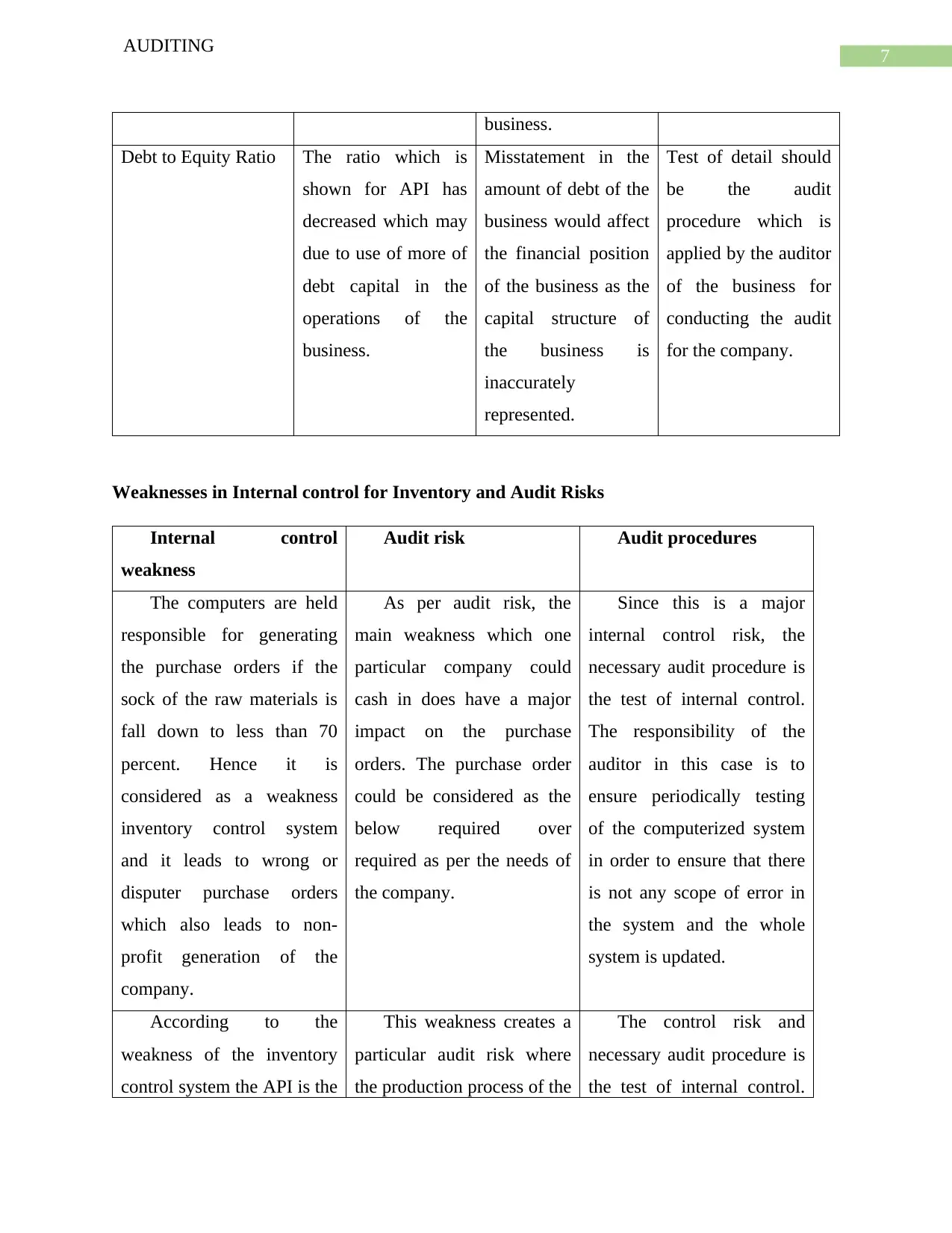
7
AUDITING
business.
Debt to Equity Ratio The ratio which is
shown for API has
decreased which may
due to use of more of
debt capital in the
operations of the
business.
Misstatement in the
amount of debt of the
business would affect
the financial position
of the business as the
capital structure of
the business is
inaccurately
represented.
Test of detail should
be the audit
procedure which is
applied by the auditor
of the business for
conducting the audit
for the company.
Weaknesses in Internal control for Inventory and Audit Risks
Internal control
weakness
Audit risk Audit procedures
The computers are held
responsible for generating
the purchase orders if the
sock of the raw materials is
fall down to less than 70
percent. Hence it is
considered as a weakness
inventory control system
and it leads to wrong or
disputer purchase orders
which also leads to non-
profit generation of the
company.
As per audit risk, the
main weakness which one
particular company could
cash in does have a major
impact on the purchase
orders. The purchase order
could be considered as the
below required over
required as per the needs of
the company.
Since this is a major
internal control risk, the
necessary audit procedure is
the test of internal control.
The responsibility of the
auditor in this case is to
ensure periodically testing
of the computerized system
in order to ensure that there
is not any scope of error in
the system and the whole
system is updated.
According to the
weakness of the inventory
control system the API is the
This weakness creates a
particular audit risk where
the production process of the
The control risk and
necessary audit procedure is
the test of internal control.
AUDITING
business.
Debt to Equity Ratio The ratio which is
shown for API has
decreased which may
due to use of more of
debt capital in the
operations of the
business.
Misstatement in the
amount of debt of the
business would affect
the financial position
of the business as the
capital structure of
the business is
inaccurately
represented.
Test of detail should
be the audit
procedure which is
applied by the auditor
of the business for
conducting the audit
for the company.
Weaknesses in Internal control for Inventory and Audit Risks
Internal control
weakness
Audit risk Audit procedures
The computers are held
responsible for generating
the purchase orders if the
sock of the raw materials is
fall down to less than 70
percent. Hence it is
considered as a weakness
inventory control system
and it leads to wrong or
disputer purchase orders
which also leads to non-
profit generation of the
company.
As per audit risk, the
main weakness which one
particular company could
cash in does have a major
impact on the purchase
orders. The purchase order
could be considered as the
below required over
required as per the needs of
the company.
Since this is a major
internal control risk, the
necessary audit procedure is
the test of internal control.
The responsibility of the
auditor in this case is to
ensure periodically testing
of the computerized system
in order to ensure that there
is not any scope of error in
the system and the whole
system is updated.
According to the
weakness of the inventory
control system the API is the
This weakness creates a
particular audit risk where
the production process of the
The control risk and
necessary audit procedure is
the test of internal control.
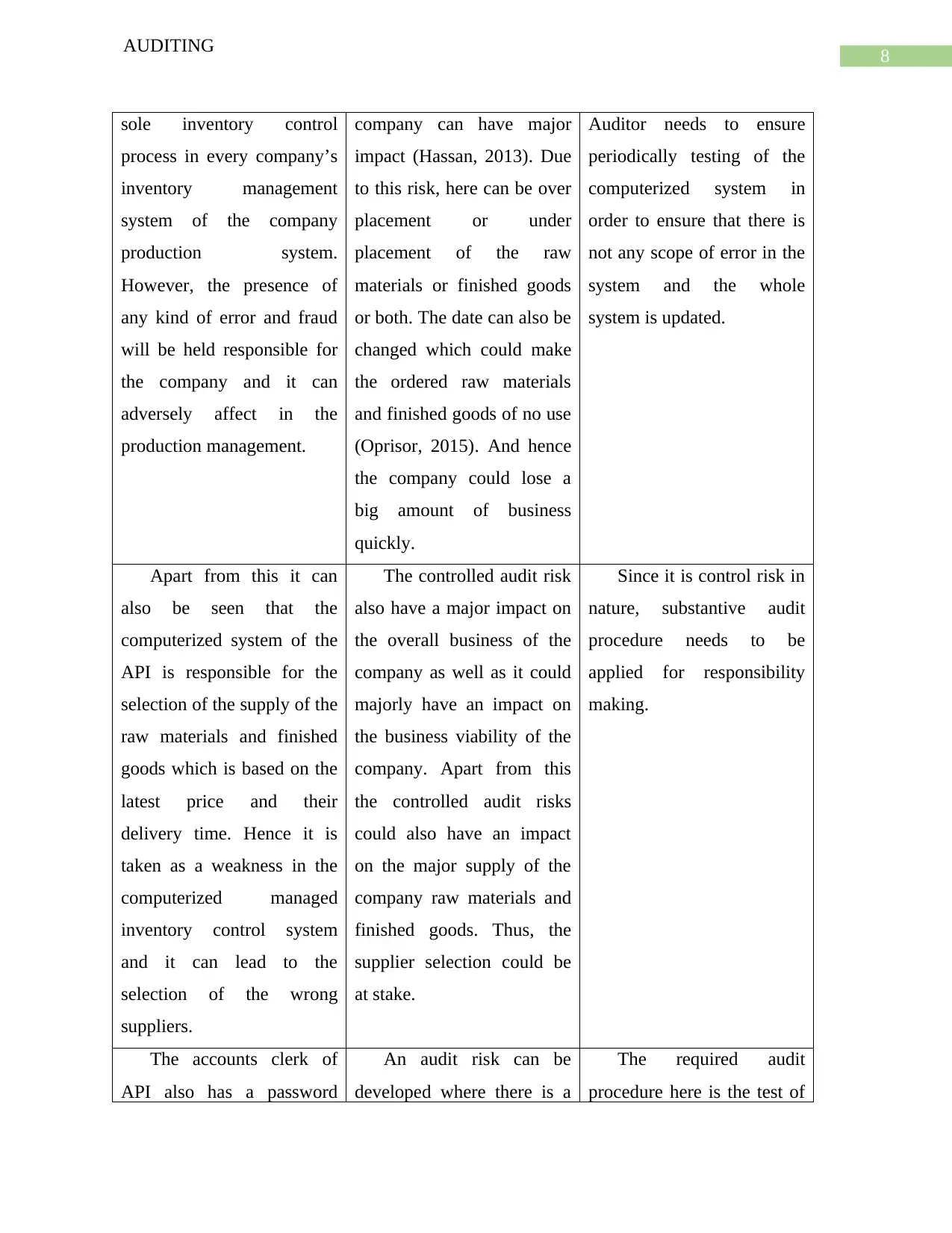
8
AUDITING
sole inventory control
process in every company’s
inventory management
system of the company
production system.
However, the presence of
any kind of error and fraud
will be held responsible for
the company and it can
adversely affect in the
production management.
company can have major
impact (Hassan, 2013). Due
to this risk, here can be over
placement or under
placement of the raw
materials or finished goods
or both. The date can also be
changed which could make
the ordered raw materials
and finished goods of no use
(Oprisor, 2015). And hence
the company could lose a
big amount of business
quickly.
Auditor needs to ensure
periodically testing of the
computerized system in
order to ensure that there is
not any scope of error in the
system and the whole
system is updated.
Apart from this it can
also be seen that the
computerized system of the
API is responsible for the
selection of the supply of the
raw materials and finished
goods which is based on the
latest price and their
delivery time. Hence it is
taken as a weakness in the
computerized managed
inventory control system
and it can lead to the
selection of the wrong
suppliers.
The controlled audit risk
also have a major impact on
the overall business of the
company as well as it could
majorly have an impact on
the business viability of the
company. Apart from this
the controlled audit risks
could also have an impact
on the major supply of the
company raw materials and
finished goods. Thus, the
supplier selection could be
at stake.
Since it is control risk in
nature, substantive audit
procedure needs to be
applied for responsibility
making.
The accounts clerk of
API also has a password
An audit risk can be
developed where there is a
The required audit
procedure here is the test of
AUDITING
sole inventory control
process in every company’s
inventory management
system of the company
production system.
However, the presence of
any kind of error and fraud
will be held responsible for
the company and it can
adversely affect in the
production management.
company can have major
impact (Hassan, 2013). Due
to this risk, here can be over
placement or under
placement of the raw
materials or finished goods
or both. The date can also be
changed which could make
the ordered raw materials
and finished goods of no use
(Oprisor, 2015). And hence
the company could lose a
big amount of business
quickly.
Auditor needs to ensure
periodically testing of the
computerized system in
order to ensure that there is
not any scope of error in the
system and the whole
system is updated.
Apart from this it can
also be seen that the
computerized system of the
API is responsible for the
selection of the supply of the
raw materials and finished
goods which is based on the
latest price and their
delivery time. Hence it is
taken as a weakness in the
computerized managed
inventory control system
and it can lead to the
selection of the wrong
suppliers.
The controlled audit risk
also have a major impact on
the overall business of the
company as well as it could
majorly have an impact on
the business viability of the
company. Apart from this
the controlled audit risks
could also have an impact
on the major supply of the
company raw materials and
finished goods. Thus, the
supplier selection could be
at stake.
Since it is control risk in
nature, substantive audit
procedure needs to be
applied for responsibility
making.
The accounts clerk of
API also has a password
An audit risk can be
developed where there is a
The required audit
procedure here is the test of

9
AUDITING
access of the master
amendments while it is
responsible for filling the
purchase orders and GRN.
Hence it is considered as a
major weakness of the
internal control system of
the inventory.
chance of thee company
accounts clerk who could
easily play with the
company master file and
change things within it.
details where auditor needs
to test all the documents
related to the master file so
that fraud can be detected.
In other ways also, it can
be seen that the production
control and the password
access required for printing
the production order and
master file amendments.
Hence it is also a weakness
of the internal control and
the company production
(Needles, Powers &
Crosson, 2013) manager
could amend he master file
by manipulatively printing
the wrong production file.
The over and under
production of the products
and services during a
particular month could have
an adverse effect on the
company audit policy for the
financial years and hence the
things could react according
to that stage. Thus, variance
in the company production
could well be having an
adverse effect on the audit
value of the company.
Proper segregation of
responsibility is the correct
audit step where it is needed
to deter the production
controller from having these
two responsibilities.
Other than that the store
staff have the access over
password over both the
printing of the raw materials
as well as the GRN printing
and printing the same for the
finished goods. Thus the
frauds could be detected in
this case and since the
An audit risk is
associated with this
weakness where the
purchase of raw materials
and production of finished
goods can be adversely
affected.
The main audit step here
is the segregation of duty
where two staffs will be
responsible for purchase
order printing and GRN
printing respectively.
AUDITING
access of the master
amendments while it is
responsible for filling the
purchase orders and GRN.
Hence it is considered as a
major weakness of the
internal control system of
the inventory.
chance of thee company
accounts clerk who could
easily play with the
company master file and
change things within it.
details where auditor needs
to test all the documents
related to the master file so
that fraud can be detected.
In other ways also, it can
be seen that the production
control and the password
access required for printing
the production order and
master file amendments.
Hence it is also a weakness
of the internal control and
the company production
(Needles, Powers &
Crosson, 2013) manager
could amend he master file
by manipulatively printing
the wrong production file.
The over and under
production of the products
and services during a
particular month could have
an adverse effect on the
company audit policy for the
financial years and hence the
things could react according
to that stage. Thus, variance
in the company production
could well be having an
adverse effect on the audit
value of the company.
Proper segregation of
responsibility is the correct
audit step where it is needed
to deter the production
controller from having these
two responsibilities.
Other than that the store
staff have the access over
password over both the
printing of the raw materials
as well as the GRN printing
and printing the same for the
finished goods. Thus the
frauds could be detected in
this case and since the
An audit risk is
associated with this
weakness where the
purchase of raw materials
and production of finished
goods can be adversely
affected.
The main audit step here
is the segregation of duty
where two staffs will be
responsible for purchase
order printing and GRN
printing respectively.
Secure Best Marks with AI Grader
Need help grading? Try our AI Grader for instant feedback on your assignments.
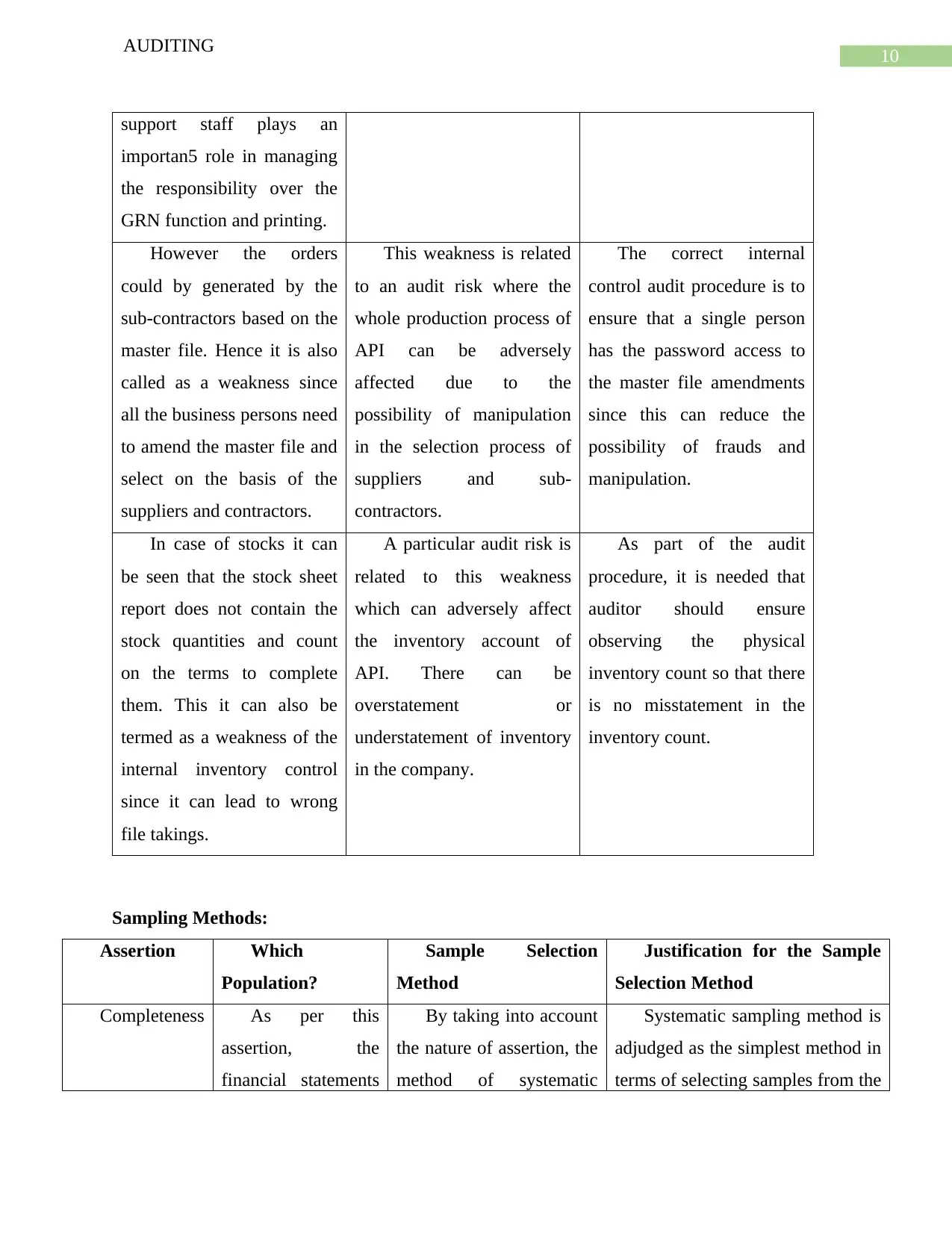
10
AUDITING
support staff plays an
importan5 role in managing
the responsibility over the
GRN function and printing.
However the orders
could by generated by the
sub-contractors based on the
master file. Hence it is also
called as a weakness since
all the business persons need
to amend the master file and
select on the basis of the
suppliers and contractors.
This weakness is related
to an audit risk where the
whole production process of
API can be adversely
affected due to the
possibility of manipulation
in the selection process of
suppliers and sub-
contractors.
The correct internal
control audit procedure is to
ensure that a single person
has the password access to
the master file amendments
since this can reduce the
possibility of frauds and
manipulation.
In case of stocks it can
be seen that the stock sheet
report does not contain the
stock quantities and count
on the terms to complete
them. This it can also be
termed as a weakness of the
internal inventory control
since it can lead to wrong
file takings.
A particular audit risk is
related to this weakness
which can adversely affect
the inventory account of
API. There can be
overstatement or
understatement of inventory
in the company.
As part of the audit
procedure, it is needed that
auditor should ensure
observing the physical
inventory count so that there
is no misstatement in the
inventory count.
Sampling Methods:
Assertion Which
Population?
Sample Selection
Method
Justification for the Sample
Selection Method
Completeness As per this
assertion, the
financial statements
By taking into account
the nature of assertion, the
method of systematic
Systematic sampling method is
adjudged as the simplest method in
terms of selecting samples from the
AUDITING
support staff plays an
importan5 role in managing
the responsibility over the
GRN function and printing.
However the orders
could by generated by the
sub-contractors based on the
master file. Hence it is also
called as a weakness since
all the business persons need
to amend the master file and
select on the basis of the
suppliers and contractors.
This weakness is related
to an audit risk where the
whole production process of
API can be adversely
affected due to the
possibility of manipulation
in the selection process of
suppliers and sub-
contractors.
The correct internal
control audit procedure is to
ensure that a single person
has the password access to
the master file amendments
since this can reduce the
possibility of frauds and
manipulation.
In case of stocks it can
be seen that the stock sheet
report does not contain the
stock quantities and count
on the terms to complete
them. This it can also be
termed as a weakness of the
internal inventory control
since it can lead to wrong
file takings.
A particular audit risk is
related to this weakness
which can adversely affect
the inventory account of
API. There can be
overstatement or
understatement of inventory
in the company.
As part of the audit
procedure, it is needed that
auditor should ensure
observing the physical
inventory count so that there
is no misstatement in the
inventory count.
Sampling Methods:
Assertion Which
Population?
Sample Selection
Method
Justification for the Sample
Selection Method
Completeness As per this
assertion, the
financial statements
By taking into account
the nature of assertion, the
method of systematic
Systematic sampling method is
adjudged as the simplest method in
terms of selecting samples from the
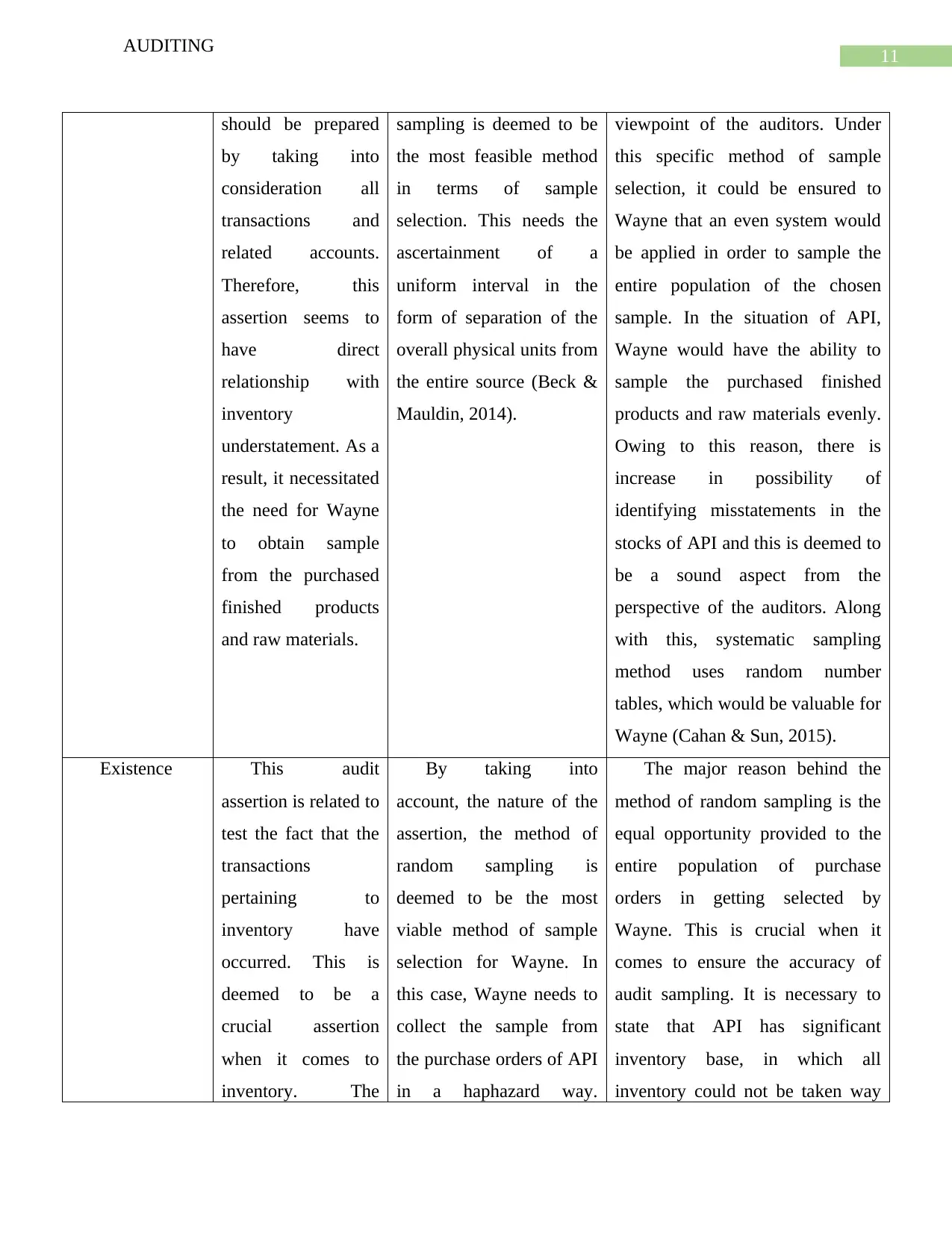
11
AUDITING
should be prepared
by taking into
consideration all
transactions and
related accounts.
Therefore, this
assertion seems to
have direct
relationship with
inventory
understatement. As a
result, it necessitated
the need for Wayne
to obtain sample
from the purchased
finished products
and raw materials.
sampling is deemed to be
the most feasible method
in terms of sample
selection. This needs the
ascertainment of a
uniform interval in the
form of separation of the
overall physical units from
the entire source (Beck &
Mauldin, 2014).
viewpoint of the auditors. Under
this specific method of sample
selection, it could be ensured to
Wayne that an even system would
be applied in order to sample the
entire population of the chosen
sample. In the situation of API,
Wayne would have the ability to
sample the purchased finished
products and raw materials evenly.
Owing to this reason, there is
increase in possibility of
identifying misstatements in the
stocks of API and this is deemed to
be a sound aspect from the
perspective of the auditors. Along
with this, systematic sampling
method uses random number
tables, which would be valuable for
Wayne (Cahan & Sun, 2015).
Existence This audit
assertion is related to
test the fact that the
transactions
pertaining to
inventory have
occurred. This is
deemed to be a
crucial assertion
when it comes to
inventory. The
By taking into
account, the nature of the
assertion, the method of
random sampling is
deemed to be the most
viable method of sample
selection for Wayne. In
this case, Wayne needs to
collect the sample from
the purchase orders of API
in a haphazard way.
The major reason behind the
method of random sampling is the
equal opportunity provided to the
entire population of purchase
orders in getting selected by
Wayne. This is crucial when it
comes to ensure the accuracy of
audit sampling. It is necessary to
state that API has significant
inventory base, in which all
inventory could not be taken way
AUDITING
should be prepared
by taking into
consideration all
transactions and
related accounts.
Therefore, this
assertion seems to
have direct
relationship with
inventory
understatement. As a
result, it necessitated
the need for Wayne
to obtain sample
from the purchased
finished products
and raw materials.
sampling is deemed to be
the most feasible method
in terms of sample
selection. This needs the
ascertainment of a
uniform interval in the
form of separation of the
overall physical units from
the entire source (Beck &
Mauldin, 2014).
viewpoint of the auditors. Under
this specific method of sample
selection, it could be ensured to
Wayne that an even system would
be applied in order to sample the
entire population of the chosen
sample. In the situation of API,
Wayne would have the ability to
sample the purchased finished
products and raw materials evenly.
Owing to this reason, there is
increase in possibility of
identifying misstatements in the
stocks of API and this is deemed to
be a sound aspect from the
perspective of the auditors. Along
with this, systematic sampling
method uses random number
tables, which would be valuable for
Wayne (Cahan & Sun, 2015).
Existence This audit
assertion is related to
test the fact that the
transactions
pertaining to
inventory have
occurred. This is
deemed to be a
crucial assertion
when it comes to
inventory. The
By taking into
account, the nature of the
assertion, the method of
random sampling is
deemed to be the most
viable method of sample
selection for Wayne. In
this case, Wayne needs to
collect the sample from
the purchase orders of API
in a haphazard way.
The major reason behind the
method of random sampling is the
equal opportunity provided to the
entire population of purchase
orders in getting selected by
Wayne. This is crucial when it
comes to ensure the accuracy of
audit sampling. It is necessary to
state that API has significant
inventory base, in which all
inventory could not be taken way

12
AUDITING
auditor needs to
select the sample
from the raw
material purchase
owing to the
inability of any
scope in vouching
them as opposed to
the purchase
requisition.
Vouching is a
significant process,
in which the auditors
have to identify a
specific amount to
supporting
documents.
Therefore, this process
requires the usage of
random number tables
(Dedman, Kausar &
Lennox, 2014).
and thus, the application of random
sampling is deemed to be fit for
API (Huang et al., 2014).
AUDITING
auditor needs to
select the sample
from the raw
material purchase
owing to the
inability of any
scope in vouching
them as opposed to
the purchase
requisition.
Vouching is a
significant process,
in which the auditors
have to identify a
specific amount to
supporting
documents.
Therefore, this process
requires the usage of
random number tables
(Dedman, Kausar &
Lennox, 2014).
and thus, the application of random
sampling is deemed to be fit for
API (Huang et al., 2014).
Paraphrase This Document
Need a fresh take? Get an instant paraphrase of this document with our AI Paraphraser
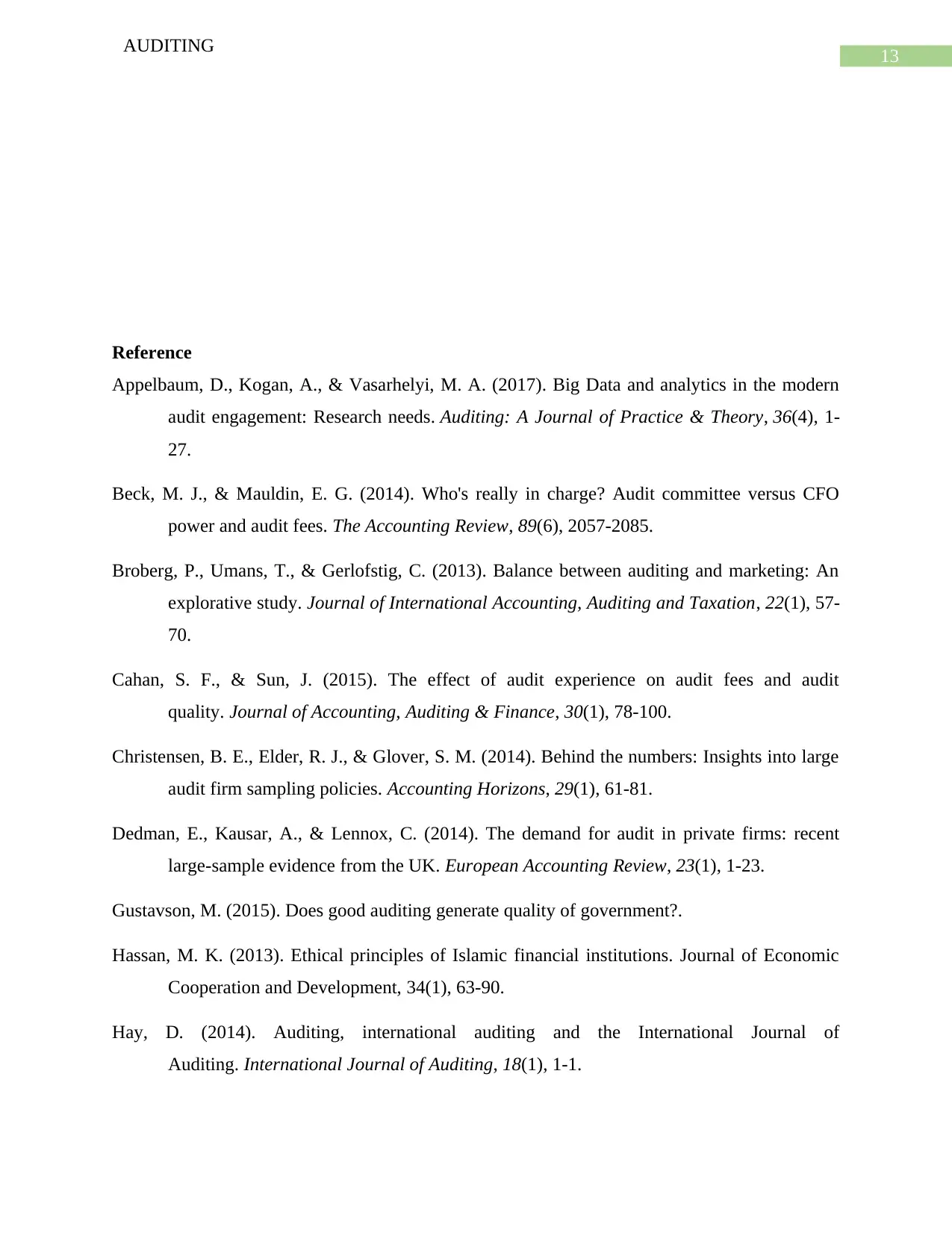
13
AUDITING
Reference
Appelbaum, D., Kogan, A., & Vasarhelyi, M. A. (2017). Big Data and analytics in the modern
audit engagement: Research needs. Auditing: A Journal of Practice & Theory, 36(4), 1-
27.
Beck, M. J., & Mauldin, E. G. (2014). Who's really in charge? Audit committee versus CFO
power and audit fees. The Accounting Review, 89(6), 2057-2085.
Broberg, P., Umans, T., & Gerlofstig, C. (2013). Balance between auditing and marketing: An
explorative study. Journal of International Accounting, Auditing and Taxation, 22(1), 57-
70.
Cahan, S. F., & Sun, J. (2015). The effect of audit experience on audit fees and audit
quality. Journal of Accounting, Auditing & Finance, 30(1), 78-100.
Christensen, B. E., Elder, R. J., & Glover, S. M. (2014). Behind the numbers: Insights into large
audit firm sampling policies. Accounting Horizons, 29(1), 61-81.
Dedman, E., Kausar, A., & Lennox, C. (2014). The demand for audit in private firms: recent
large-sample evidence from the UK. European Accounting Review, 23(1), 1-23.
Gustavson, M. (2015). Does good auditing generate quality of government?.
Hassan, M. K. (2013). Ethical principles of Islamic financial institutions. Journal of Economic
Cooperation and Development, 34(1), 63-90.
Hay, D. (2014). Auditing, international auditing and the International Journal of
Auditing. International Journal of Auditing, 18(1), 1-1.
AUDITING
Reference
Appelbaum, D., Kogan, A., & Vasarhelyi, M. A. (2017). Big Data and analytics in the modern
audit engagement: Research needs. Auditing: A Journal of Practice & Theory, 36(4), 1-
27.
Beck, M. J., & Mauldin, E. G. (2014). Who's really in charge? Audit committee versus CFO
power and audit fees. The Accounting Review, 89(6), 2057-2085.
Broberg, P., Umans, T., & Gerlofstig, C. (2013). Balance between auditing and marketing: An
explorative study. Journal of International Accounting, Auditing and Taxation, 22(1), 57-
70.
Cahan, S. F., & Sun, J. (2015). The effect of audit experience on audit fees and audit
quality. Journal of Accounting, Auditing & Finance, 30(1), 78-100.
Christensen, B. E., Elder, R. J., & Glover, S. M. (2014). Behind the numbers: Insights into large
audit firm sampling policies. Accounting Horizons, 29(1), 61-81.
Dedman, E., Kausar, A., & Lennox, C. (2014). The demand for audit in private firms: recent
large-sample evidence from the UK. European Accounting Review, 23(1), 1-23.
Gustavson, M. (2015). Does good auditing generate quality of government?.
Hassan, M. K. (2013). Ethical principles of Islamic financial institutions. Journal of Economic
Cooperation and Development, 34(1), 63-90.
Hay, D. (2014). Auditing, international auditing and the International Journal of
Auditing. International Journal of Auditing, 18(1), 1-1.
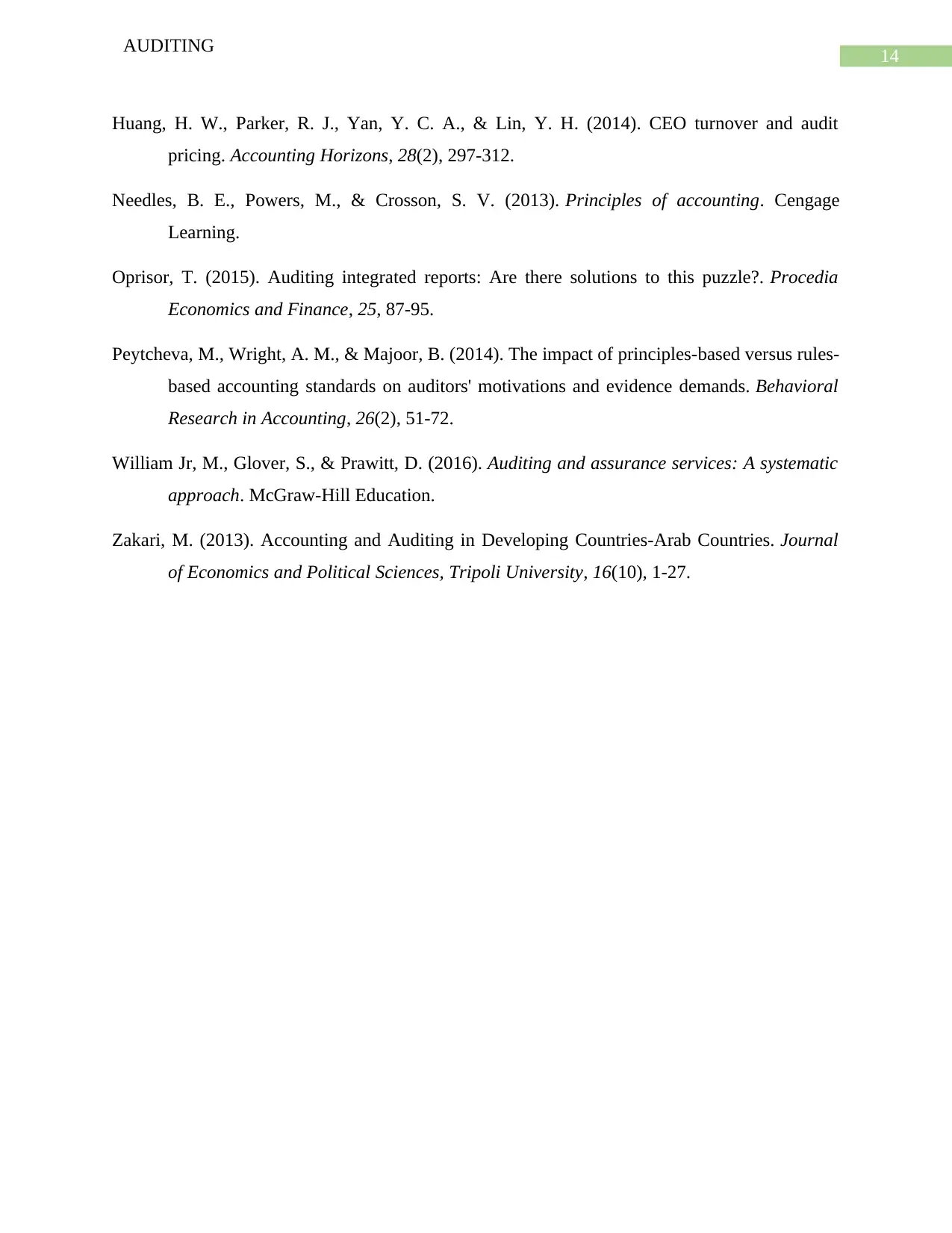
14
AUDITING
Huang, H. W., Parker, R. J., Yan, Y. C. A., & Lin, Y. H. (2014). CEO turnover and audit
pricing. Accounting Horizons, 28(2), 297-312.
Needles, B. E., Powers, M., & Crosson, S. V. (2013). Principles of accounting. Cengage
Learning.
Oprisor, T. (2015). Auditing integrated reports: Are there solutions to this puzzle?. Procedia
Economics and Finance, 25, 87-95.
Peytcheva, M., Wright, A. M., & Majoor, B. (2014). The impact of principles-based versus rules-
based accounting standards on auditors' motivations and evidence demands. Behavioral
Research in Accounting, 26(2), 51-72.
William Jr, M., Glover, S., & Prawitt, D. (2016). Auditing and assurance services: A systematic
approach. McGraw-Hill Education.
Zakari, M. (2013). Accounting and Auditing in Developing Countries-Arab Countries. Journal
of Economics and Political Sciences, Tripoli University, 16(10), 1-27.
AUDITING
Huang, H. W., Parker, R. J., Yan, Y. C. A., & Lin, Y. H. (2014). CEO turnover and audit
pricing. Accounting Horizons, 28(2), 297-312.
Needles, B. E., Powers, M., & Crosson, S. V. (2013). Principles of accounting. Cengage
Learning.
Oprisor, T. (2015). Auditing integrated reports: Are there solutions to this puzzle?. Procedia
Economics and Finance, 25, 87-95.
Peytcheva, M., Wright, A. M., & Majoor, B. (2014). The impact of principles-based versus rules-
based accounting standards on auditors' motivations and evidence demands. Behavioral
Research in Accounting, 26(2), 51-72.
William Jr, M., Glover, S., & Prawitt, D. (2016). Auditing and assurance services: A systematic
approach. McGraw-Hill Education.
Zakari, M. (2013). Accounting and Auditing in Developing Countries-Arab Countries. Journal
of Economics and Political Sciences, Tripoli University, 16(10), 1-27.
1 out of 15
Related Documents
Your All-in-One AI-Powered Toolkit for Academic Success.
+13062052269
info@desklib.com
Available 24*7 on WhatsApp / Email
![[object Object]](/_next/static/media/star-bottom.7253800d.svg)
Unlock your academic potential
© 2024 | Zucol Services PVT LTD | All rights reserved.





